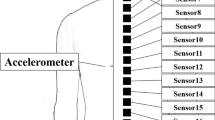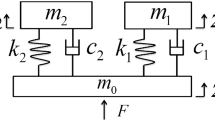Abstract.
A method is proposed for identifying the head-neck complex (HNC) in the seated human body when it is exposed to the trunk horizontal (fore-and-aft) vibration. It is assumed that the HNC only has the anteroposterior (flexion/extension) motion in the sagittal plane. An electrohydraulic vibrator is used as a source of vibration. To generate the trunk horizontal vibration, the trunk of the seated subject is fixed to the seatback. The subjects are exposed to the random vibration at a magnitude of 1.60 ms-2 rms (root-mean-square) for 50 s. The coherence and frequency response function are then obtained in the frequency range 0.5–3 Hz. The results show that the HNC behavior is quasilinear with a resonance frequency between 1 and 1.4 Hz. Accordingly, a two-dimensional single-inverted pendulum is considered as a model for the HNC. The frequency domain identification method is then used to estimate the unknown parameters, including the HNC viscoelastic and inertia parameters. The model is examined in a time domain using the random vibration. Good agreement is obtained between experimental and simulation results, indicating the reliability of the proposed method.
Similar content being viewed by others
References
Bendat JS (1997) Nonlinear systems techniques and applications. Wiley, New York
Bendat JS, Piersol AG (1980) Engineering applications of correlation and spectral analysis. Wiley, New York
Cholewicki J, Panjabi MM, Nibu K, Babat LB, Grauer JN, Dvorak J (1998) Head kinematics during in vitro whiplash simulation. Accid Anal Prev 30:469–479
De Leva P (1996) Adjusments to Zatsiorsky-Seluyanov’s segment inertia parameters. J Biomech 29:1223–1230
Griffin MJ (1996) Handbook of human vibration. Academic Press, London, pp 43–65
Guitton D, Kearney RE, Wereley N, Peterson BW (1986) Visual, vestibular and voluntary contributions to human head stabilization. Exp Brain Res 64:59–69
Ishida A, Miyazaki S (1987) Maximum likelihood identification of a posture control system. IEEE Trans Biomed Eng BME-34:1–5
Ishida A, Shoji I, Fukuoka Y (1997) Analysis of the postural control system under fixed and sway-referenced support conditions. IEEE Trans Biomed Eng 44:331–336
Johansson R, Magnusson M, Akesson M (1988) Identification of human postural dynamics. IEEE Trans Biomed Eng 35:858–869
Keshner EA, Peterson BW (1995) Mechanisms controlling human head stabilization: I. Head-neck characteristics during random rotations in the horizontal plane. J Neurophysiol 73:2293–2301
Keshner EA, Cromwell RL, Peterson BW (1995) Mechanisms controlling human head stabilization: II. Head-neck characteristics during random rotations in the vertical plane. J Neurophysiol 73:2302–2312
Keshner EA (2000) Modulating active stiffness affects head stabilizing strategies in young and elderly adults during trunk rotations in the vertical plane. Gait Posture 11:1–11
Kitazaki S, Griffin MJ (1998) Resonance behavior of the seated human body and effects of posture. J Biomech 31:143–149
Kollar I (2001) Frequency domain system identification toolbox – user’s guide. Mathworks, Natick, MA
Linder A (2000) A new mathematical neck model for a low-velocity rear-end impact dummy: evaluation of components influencing head kinematics. Accid Anal Prev 32:261–269
Overschee PV, Moor BD (1996) Subspace identification for linear systems. Kluwer, Dordrecht, The Netherlands
Paddan GS, Griffin MJ (1988a) The transmission of translational seat vibration to the head: I. Vertical seat vibration. J Biomech 21:191–197
Paddan GS, Griffin MJ (1988b) The transmission of translational seat vibration to the head: II. Horizontal vibration. J Biomech 21:199–206
Peng GCY, Hain TC, Peterson BW (1996) A dynamical model for reflex activated head movements in the horizontal plane. Biol Cybern 75:309–319
Perreault EJ, Crago PE, Kirsch RF (2000) Estimation of intrinsic and reflex contributions to muscle dynamics: a modeling study. IEEE Trans Biomed Eng 47:1413–1421
Peterka RJ (2000) Postural control model interpretation of stabilogram diffusion analysis. Biol Cybern 82:335–343
Pintelon R, Schoukens J (2001) System identification: a frequency domain approach. IEEE Press, New York
Pintelon R, Schoukens J, Renneboog J (1988) The geometric mean of power (amplitude) spectra has a much smaller bias than the classical arithmetic (RMS) averaging. IEEE Trans Instrum Meas 37:213–218
Qassem W (1996) Model prediction of vibration effects on human subject seated on various cushions. Med Eng Phys 18:350–358
Schoukens J, Pintelon R (1990) Measurement of frequency response functions in noisy environments. IEEE Trans Instrum Meas 39:905–909
Schoukens J, Pintelon R, Rolain Y, Dobrowiecki T (2001) Frequency response function measurements in the presence of nonlinear distortions. Automatica 37:939–946
Viviani P, Berthoz A (1975) Dynamics of the head-neck system in response to small perturbations: analysis and modeling in the frequency domain. Biol Cybern 19:19–37
Author information
Authors and Affiliations
Corresponding author
Rights and permissions
About this article
Cite this article
Fard, M., Ishihara, T. & Inooka, H. Identification of the head-neck complex in response to trunk horizontal vibration. Biol. Cybern. 90, 418–426 (2004). https://doi.org/10.1007/s00422-004-0489-z
Received:
Accepted:
Published:
Issue Date:
DOI: https://doi.org/10.1007/s00422-004-0489-z




